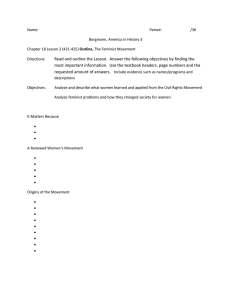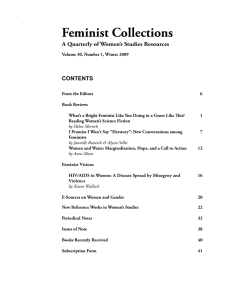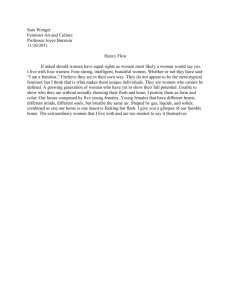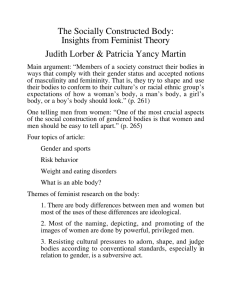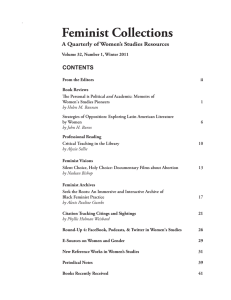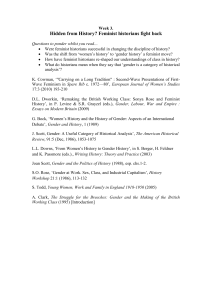HDF 407 Syllabus
advertisement
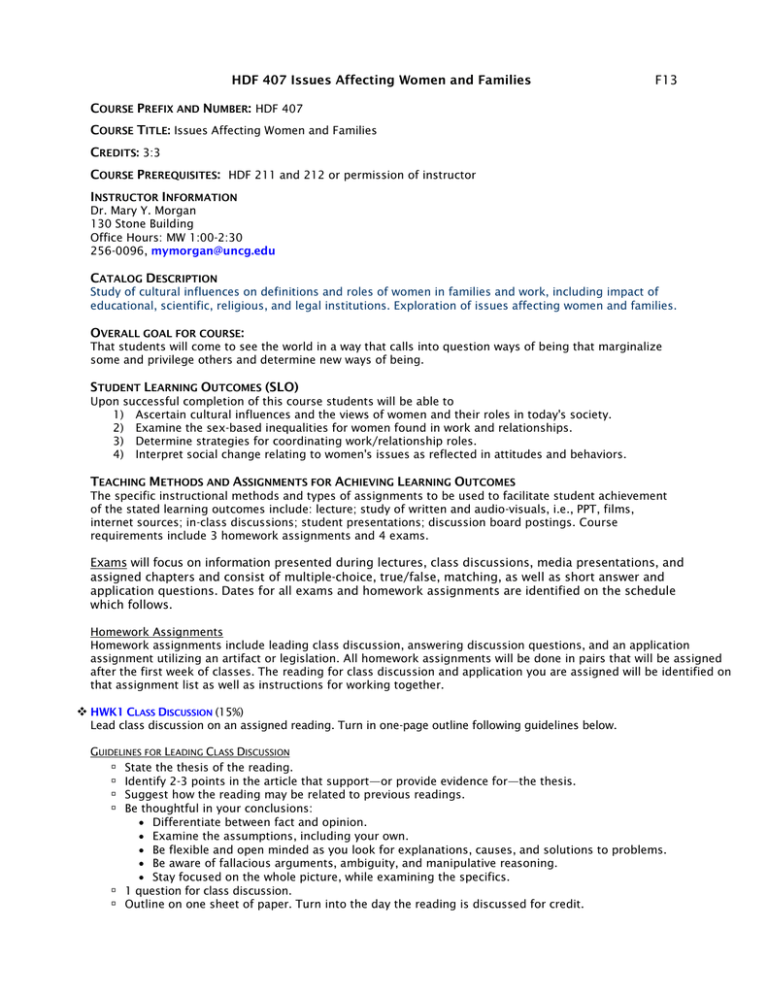
HDF 407 Issues Affecting Women and Families F13 COURSE PREFIX AND NUMBER: HDF 407 COURSE TITLE: Issues Affecting Women and Families CREDITS: 3:3 COURSE PREREQUISITES: HDF 211 and 212 or permission of instructor INSTRUCTOR INFORMATION Dr. Mary Y. Morgan 130 Stone Building Office Hours: MW 1:00-2:30 256-0096, mymorgan@uncg.edu CATALOG DESCRIPTION Study of cultural influences on definitions and roles of women in families and work, including impact of educational, scientific, religious, and legal institutions. Exploration of issues affecting women and families. OVERALL GOAL FOR COURSE: That students will come to see the world in a way that calls into question ways of being that marginalize some and privilege others and determine new ways of being. STUDENT LEARNING OUTCOMES (SLO) Upon successful completion of this course students will be able to 1) Ascertain cultural influences and the views of women and their roles in today's society. 2) Examine the sex-based inequalities for women found in work and relationships. 3) Determine strategies for coordinating work/relationship roles. 4) Interpret social change relating to women's issues as reflected in attitudes and behaviors. TEACHING METHODS AND ASSIGNMENTS FOR ACHIEVING LEARNING OUTCOMES The specific instructional methods and types of assignments to be used to facilitate student achievement of the stated learning outcomes include: lecture; study of written and audio-visuals, i.e., PPT, films, internet sources; in-class discussions; student presentations; discussion board postings. Course requirements include 3 homework assignments and 4 exams. Exams will focus on information presented during lectures, class discussions, media presentations, and assigned chapters and consist of multiple-choice, true/false, matching, as well as short answer and application questions. Dates for all exams and homework assignments are identified on the schedule which follows. Homework Assignments Homework assignments include leading class discussion, answering discussion questions, and an application assignment utilizing an artifact or legislation. All homework assignments will be done in pairs that will be assigned after the first week of classes. The reading for class discussion and application you are assigned will be identified on that assignment list as well as instructions for working together. HWK1 CLASS DISCUSSION (15%) Lead class discussion on an assigned reading. Turn in one-page outline following guidelines below. GUIDELINES FOR LEADING CLASS DISCUSSION State the thesis of the reading. Identify 2-3 points in the article that support—or provide evidence for—the thesis. Suggest how the reading may be related to previous readings. Be thoughtful in your conclusions: Differentiate between fact and opinion. Examine the assumptions, including your own. Be flexible and open minded as you look for explanations, causes, and solutions to problems. Be aware of fallacious arguments, ambiguity, and manipulative reasoning. Stay focused on the whole picture, while examining the specifics. 1 question for class discussion. Outline on one sheet of paper. Turn into the day the reading is discussed for credit. 2 HWK 2 APPLICATION ASSIGNMENTS [You will be assigned one of these, either (1) artifact OR (2) Legislation] (15%) (1) ARTIFACT Collect an “artifact” from the media (that is, articles, photographs, essays in periodicals, radio or TV transcripts, web sources, etc.) that relate to the readings in law, science, and religion in Institutions of Control. Compare the artifact with the reading(s), and turn in a paper for each using the following guidelines. Share in class on the day the reading is discussed and post on Blackboard. GUIDELINES FOR ARTIFACTS Identify source, e.g., site, date, author, etc. Describe the artifact. Compare artifact with the reading(s). Ask: How is it consistent with information in the readings? What differs in this artifact from your readings? What does this tell you? Elaborate on the aspect of the readings that relates to the artifact. e.g., What is the reading saying? How does the reading illuminate the message of the artifact? Type on 2 pages (max) with 1-inch margins, using Arial 10-point font. Attach artifact if possible. (2) LEGISLATIVE APPLICATION Find an example of legislation (proposed or passed within the past 2 years) that relate to one of the readings in the last section, Work and Families. Turn in a summary comparing the legislation to the reading(s) using the following guidelines. Share in class on the day the reading is discussed or during the final. GUIDELINES FOR LEGISLATIVE ASSIGNMENT Create a heading for the topic. Identify readings (at least 2) by author(s). Write 2-3 sentences about the issue from the readings. Identify the legislation. State source of legislation (e.g., web site). Write 2-3 sentences about the legislation. Write 4-5 sentences comparing/contrasting the legislation with the reading. Type on 2 pages (max) with 1-inch margins, using Arial 10-point font. Attach first page of legislation. HELPFUL WEB-SITES http://www.senate.gov/pagelayout/legislative/g_three_sections_with_teasers/legislative_home.htm http://thomas.loc.gov/home/thomas.html http://www.ncfr.org/about_us/a_p_p_policy_links.asp http://www.nwlc.org EXAMS (70%) 4 Exams: objective, short answers. GRADING AND EVALUATION: The homework assignments are worth 40% of the total grade; the exams are worth 60% of the total grade as follows: HWK 1 (Class Discussion) = 15% HWK 2 (Application Assignment) = 15% EX1 (Construction of Oppression) = 15% EX2 (Cultural Institutions) = 20% EX3 (Institutions of Control) = 20% EX4 (Work and Families) = 15% Grades are based on a 10-point scale (90-100% = A, 80-89% = B; 70-79% = C; 60-69% = D; below 60% = F). Pluses (% ending in 7, 8, and 9) and minuses (% ending in 0, 1, and 2) will be assigned when final grades are determined. Scores on assignments and exams will be posted on blackboard where you can keep track of your grade throughout the semester. 3 This rubric will be used to evaluate your homework assignments. Homework Rubric .5 PRESENTATION ORGANIZATION ACCURACY 1 1.5 Few grammatical or spelling errors 2 Utilizes poor spelling and grammar; assignments appear "hasty" Some spelling and grammatical errors Consistently grammatically correct with rare misspellings Lack of clarity and organization Minimal organization and clarity of ideas Ideas are mostly stated clearly; material is easy to read Ideas are expressed in a clear and concise manner Information is inadequate with several inaccuracies Inaccurate information included; assignments are short and offer limited insight into topic Information for the most part is accurate and adequate but further insight is needed Information is accurate and thorough ADDITIONAL COURSE POLICIES ACADEMIC INTEGRITY is the pursuit of scholarly activity free from fraud and deception and is an educational objective of this institution. Violating academic integrity is considered a serious offense by the university and is treated accordingly. Academic dishonesty includes, but is not limited to, cheating on exams, having unauthorized possession of exams, fabricating information or citations, facilitating the academic dishonesty of others, and submitting the work of another person as your own (plagiarism). Academic dishonesty may result in a failing grade for the particular assignment or exam, a failing grade for the entire course, or suspension or expulsion from the university. Each student is required to sign the Academic Integrity Policy on all major work submitted for the course. Refer to UNCG Undergraduate Bulletin at http://web.uncg.edu/reg/Bulletin/Current/AcaRegs/AcademicIntegrity.aspx ATTENDANCE: Students are expected to be in class, on time, and stay until the end of each class. Students who miss the first week of class without notification will be dropped from the course. More than 3 absences will result in the loss of one exam point for each class missed. Students are responsible for what happens in class when an absence does occur. This means you should contact a classmate for information rather than the instructor or post questions on Blackboard (see next item). QUESTIONS: If you have a question about class or an assignment, post it on the Q&A section of the discussion forum on Blackboard. Check this forum before posting your question, and if you need clarification on a question that has already been answered, reply to that post. CLASS PARTICIPATION in the form of comments, questions, and active engagement in classroom activities is strongly encouraged. I assume that students share equally in the learning process, which means that you are expected to attend class, pay attention and participate in class discussion and activities, complete all class assignments and exams, and read your text prior to class discussion. DUE DATES: Homework must be presented and submitted in class on the due date for full credit. No make-up exams, make-up homework, or extra credit will be given. EMERGENCIES: If you have an emergency that interferes with your ability to complete the work in this course, please let the instructor know immediately. If you cannot come for a scheduled appointment, please contact me ahead of time. My office, phone number, and email address are listed above. X1 X2 X2 4 GROUND RULES [written by Lynn Weber Cannon, Memphis State University, 1986]: 1. Acknowledge that oppression (i.e., racism, classism, sexism, homophobia, agism, etc) exists. 2. Acknowledge that one of the mechanisms of oppression is that we have been systematically taught misinformation about our own group and especially members of devalued/subordinate groups (this is true for both dominant and subordinate group members). 3. Agree not to blame ourselves or others for the misinformation we have learned in the past, but accept responsibility for not repeating misinformation after we have learned otherwise. 4. Agree not to blame victims for their oppression. 5. Assume that people (both the groups we study and the members of the class) are always doing the best they can. 6. Actively pursue information about our own groups and that of others. 7. Share information about our groups with other members of the class and we will never demean, devalue, or in any way "put down" people for their experiences. 8. Agree to actively combat the myths and stereotypes about our own groups and other groups so that we can break down the walls that prohibit group cooperation and group gain. 9. Create a safe atmosphere for open discussion. If members of the class wish to make comments that they do not want repeated outside the classroom, they can preface their remarks with a request and the class will agree not to repeat the remarks. OUTLINE OF READINGS THE CULTURAL CONSTRUCTION OF OPPRESSION 1. Commonalities and Differences among Women Commonalities and differences (excerpt) Johnnetta B. Cole Age, race, class, and sex: Women defining difference Audre Lorde And a’n’t I a woman? Sojourner Truth 2. Oppression and Privilege Oppression Marilyn Frye White privilege, male privilege Peggy McIntosh Homophobia: A weapon of sexism Suzanne Pharr2 When you meet a lesbian Indiana University Press Heterosexuality Questionnaire Speakers Bureau Still I rise Maya Angelou Labor Day—No Class 3. Feminist Theory The social construction of gender Judith Lorber Toward a new vision Patricia Hill Collins Patriarchy, the system Allan G. Johnson Feminism: a transformational politic bell hooks Theories and theorizing Gwyn Kirk & Margo Okazawa-Rey Exam 1 (objective/short answer) CULTURAL INSTITUTIONS DEFINING WOMEN [Class discussion assignments due, sections #4-12] 4. Media Advertising Beauty and the beast of advertising Jean Kilbourne *video: Killing Us Softly or Slim Hopes Sex, lies, and advertising Gloria Steinem Fashion and Beauty The beauty myth (excerpt) Naomi Wolf Obsession: the tyranny of slenderness Kim Chernim Beauty is the beast: Psychological effects… Elayne Saltzberg & Joan Chrisler Hold that nose Lisa Miya-Jervis 21Aug 23Aug 26Aug 28Aug 30Aug 2Sept 4Sept 6Sept 9Sept 11Sept 13Sept 16Sept 18Sept 20Sept 23Sept 25Sept 27Sept 5 5. Education Gender-role socialization: Lessons in femininity Hilary M. Lips When I was growing up Nellie Wong What we call each other Anndee Hochman 30Sept 2Oct Review 4Oct Exam 2 (objective/short answer) 7Oct INSTITUTIONS OF SOCIAL CONTROL [Artifact assignments are due during this section #6-8] 6. Law video: A woman’s place Women and family law: Marriage and divorce M. Margaret Conway, et al 9Oct 11Oct Fall Break—No Class 14Oct Legal images of battered women (excerpt) Martha R. Mahoney 7. 8. 16Oct Science and Medicine Women’s health Gwyn Kirk & Margo Okazawa-Rey Treating health: Women & medicine Barbara K. Rothman & Mary B. Caschetta Forgotten women: How minorities are underserved… Lisa Collier Cool Abortion through a feminist ethics lens (Excerpt) Susan Sherwin If men could menstruate Gloria Steinem 18Oct 21Oct 23Oct 25Oct Religion Out of order: A critical perspective on women in religion Martha J. Reineke Witchcraft as Goddess Religion Starhawk Grandmother of the Sun Paula Gunn Allen 28Oct 30Oct Review 2Nov Exam 3 (take-home/objective or short answer in class) 4Nov WORK AND FAMILIES CONTROL [Legislative assignments are due during this section #9 & 11] 9. Immigrant Women America’s dirty work: migrant maids… Joy Zarembka Global women Barbara Ehrenreich & Arlie Russell Hochschild 10. Motherhood Shifting the center: race, class, and feminist theorizing about motherhood Bloodmothers, othermothers, & women-centered networks Patricia Hill Collins 11. Economics of Women Families on the fault line: America’s working class… Lillian Rubin Nickel-and-dimed on (not) getting by in America Barbara Ehrenreich It’s a family affair: Women, poverty… Randy Albelda & Chris Tilly I am your welfare reform Annie Downey I was a welfare mom Cindy Ballard 12. Women’s Rights Globally The Beijing Declaration and Platform for Action Taking the global economy Kalina Rose Women’s human rights: It’s about time Rita Arditti the cleaning woman Hattie Gossett Thanksgiving—No Class Exam 3 (objective and/or short answer) Reading Day 6Nov 8Nov 11Nov 13Nov 15Nov 18Nov 20Nov 22Nov 25Nov 27-30Nov M 2Dec or W 4Dec T 3Dec 6 REQUIRED TEXTS Articles are on e-reserve through Blackboard [Go to https://blackboard.uncg.edu and login with your username and password; select “courses” and then find HDF407 under your course list; near the bottom of the Course Menu on the left, select “e-Reserves”] Readings are from the following texts: Ore, Tracy E. (Ed.) 2006. The social construction of difference and inequality. McGraw Hill. Disch, Estelle. (Ed.) 2006. Reconstructing gender: A multicultural anthology. McGraw Hill. Shaw, Susan M. & Lee, Janet. (Eds.). 2001. Women’s voices, feminist visions. Mayfield. Kirk, Gwyn & Okazawa-Rey, Margo (Eds.). 2001. Women’s lives: Multicultural perspectives. Mayfield. Lucinda Joy Peach (Ed). 1998. Women in culture: A women’s studies anthology. Blackwell. Freeman, Jo. (Ed.). 1995. Women: A feminist perspective. Mayfield. READINGS 1. Abortion through a feminist ethics lens (excerpt). From Women in culture: A women’s studies anthology, Lucinda Joy Peach (Ed.) 1998 [by] Susan Sherwin. 2. Age, race, class, and sex: women redefining difference. From Women in culture: A women’s studies anthology, Lucinda Joy Peach (Ed.) 1998 [by] Audre Lorde. 3. America’s dirty work: Migrant maids and modern-day slavery. From Reconstructing gender: A multicultural anthology. Estelle Disch (Ed.) 2006 [by] Joy M. Zarembka. 4. And a'n't I a woman? From Women in culture: A women’s studies anthology, Lucinda Joy Peach (Ed.) 1998 [by] Sojourner Truth. 5. Beauty and the beast of advertising. From Women in culture: A women’s studies anthology, Lucinda Joy Peach (Ed.) 1998 [by] Jean Kilbourne. 6. Beauty is the beast: psychological effects of the pursuit of the perfect female body. From Women: A feminist perspective, Jo Freeman (Ed.) 1995 [by] Elayne A. Saltzberg and Joan C. Chrisler. 7. Beauty myth (excerpt). From Women in culture: A woman's studies anthology, Lucinda Joy Peach (Ed.) 1998 [by] Naomi Wolf. 8. (The) Beijing declaration and platform for action. From Women’s voices, feminist visions, Susan M. Shaw and Janet Lee (Eds.) 2001 [by] Suzanne Pharr. 9. Bloodmother, othermothers, and women-centered networks. From Reconstructing gender: A multicultural anthology. Estelle Disch (Ed.) 2006 [by] Patricia Hill Collins. 10. Commonalities and differences (excerpt). From Women in culture: A women’s studies anthology, Lucinda Joy Peach (Ed.) 1998 [by] Johnnetta B. Cole. 11. Families on the fault line: America’s working class speaks about the family, the economy, race, and ethnicity. From The social construction of difference and inequality. Tracy E. Ore (Ed.) 2006 [by] Lillian Rubin. 12. Fear of feminism. From Women’s voices, feminist visions, Susan M. Shaw and Janet Lee (Eds.) 2001 [by] Lisa Maria Hogeland. 13. Feminism: A transformational politic. From Women in culture: A women’s studies anthology, Lucinda Joy Peach (Ed.) 1998 [by] bell hooks. 14. Forgotten women. From Women’s voices, feminist visions, Susan M. Shaw and Janet Lee (Eds.) 2001 [by] Lisa Collier Cool. 15. Gender-role socialization: lessons in femininity, From Women: A feminist perspective, Jo Freeman. (Ed.)1995 [by] Hilary M. Lips. 16. Gender role stressors and women's health. From Women’s voices, feminist visions, Susan M. Shaw and Janet Lee (Eds.) 2001 [by] Patti Lou Watkins and Diane Whaley. 7 17. Global woman. From Reconstructing gender: A multicultural anthology. Estelle Disch (Ed.) 2006 [by] Barbara Ehrenreich & Arlie Russell Hochschild. 18. Grandmother of the sun. From Women’s voices, feminist visions, Susan M. Shaw and Janet Lee (Eds.) 2001 [by] Paula Gunn Allen. 19. Heterosexuality questionnaire. From Women in culture: A women’s studies anthology, Lucinda Joy Peach (Ed.) 1998 [by] Gay and lesbian speaker's bureau. Hold that nose. From Women’s voices, feminist visions, Susan M. Shaw and Janet Lee. (Eds.) 2001 [by] Lisa Miya-Jervis. 20. 21. Homophobia: A weapon of sexism. From Women’s voices, feminist visions, Susan M. Shaw and Janet Lee (Eds.) 2001 [by] Suzanne Pharr. 22. How far we’ve come. From Women’s voices, feminist visions, Susan M. Shaw and Janet Lee (Eds.) 2001 [by] Harvard Women’s Health Watch. 23. I am your welfare reform. From The social construction of difference and inequality. Tracy E. Ore (Ed.) 2006 [by] Annie Downey. 24. I was a welfare mom. From Women’s voices, feminist visions, Susan M. Shaw and Janet Lee (Eds.) 2001 [by] Cindy Ballard. 25. If men could menstruate. From Women’s voices, feminist visions, Susan M. Shaw and Janet Lee (Eds.) 2001 [by] Gloria Steinem. 26. It's a family affair. From Women’s voices, feminist visions, Susan M. Shaw and Janet Lee (Eds.) 2001 [by] Randy Albelda & Chris Tilly. 27. Legal images of battered women (excerpt). From Women in culture: A women’s studies anthology, Lucinda Joy Peach (Ed.) 1998 [by] Martha R. Mahoney. 28. Nickel-and dimed on (not) getting by in America. From The social construction of difference and inequality. Tracy E. Ore (Ed.) 2006 [by] Barbara Ehrenreich. 29. Obsession: the tyranny of slenderness. From Women in culture: A women’s studies anthology, Lucinda Joy Peach (Ed.) 1998 [by] Kim Chernin. 30. Oppression. From Women in culture: A women’s studies anthology, Lucinda Joy Peach (Ed.) 1998 [by] Marilyn Frye. 31. Out of order: A critical perspective on women in religion. From Women: A feminist perspective, Jo Freeman. (Ed.) 1995 [by] Martha J. Reineke. 32. Patriarchy, the system. From Women’s lives: Multicultural perspectives, Gwyn Kirk and Margo Okazawa-Rey. (Eds.) 2001 [by] Allan G. Johnson. 33. Sex, lies, and advertising. From Women: A feminist perspective, Jo Freeman. (Ed.) 1995 [by] Gloria Steinem. 34. Sexism and the English language: the linguistic implications of being a woman. From Women: A feminist perspective, Jo Freeman. (Ed.) 1995 [by] Karen L. Adams and Norma C. Ware. 35. Shifting the center: race, class, and feminist theorizing about motherhood (excerpt). From Women in culture: A women’s studies anthology, Lucinda Joy Peach (Ed.) 1998 [by] Patricia Hill Collins. 36. Sixty cents to a man’s dollar. From Reconstructing gender: A multicultural anthology. Estelle Disch (Ed.) 2006 [by] Ann Crittenden. 37. (The) Social construction of gender. From Women’s lives: Multicultural perspectives, Gwyn Kirk and Margo Okawaza-Rey (Eds.) 2001 [by] Judith Lorber. 8 38. Still I rise. From Women in culture: A women’s studies anthology, Lucinda Joy Peach (Ed.) 1998 [by]Maya Angelou. 39. The “success” of welfare reform. From Reconstructing gender: A multicultural anthology. Estelle Disch (Ed.) 2006 [by] Sharon Hays. 40. Taking on the global economy. From Women’s lives: Multicultural perspectives, Gwyn Kirk and Margo Okawaza-Rey (Eds.) 2001 [by] Kalima Rose. 41. The Cleaning woman/labor relations #4. From Women’s lives: Multicultural perspectives, Gwyn Kirk and Margo Okazawa-Rey (Eds.) 2001 [by] Hattie Gossett. 42. Theories and theorizing: integrative frameworks for understanding. From Women’s lives: Multicultural perspectives, Gwyn Kirk and Margo Okawaza-Rey (Eds.) 2001. 43. Toward a new vision. From Women’s voices, feminist visions, Susan M. Shaw and Janet Lee (Eds.) 2001 [by] Patricia Hill Collins. 44. Treating health: women and medicine. From Women: A feminist perspective, Jo Freeman. (Ed.) 1995 [by] Barbara Katz Rothman and Mary Beth Caschetta. 45. What are little boys made of? From Women's voice, feminist visions, Susan M. Shaw and Janet Lee (Eds.) 2001 [by] Michael Kimmel. 46. What we call each other. From Women’s voices, feminist visions, Susan M. Shaw and Janet Lee (Eds.)2001 [by] Anndee Hochman 47. When I was growing up. From Women’s lives: Multicultural perspectives, Gwyn Kirk and Margo Okawaza-Rey (Eds.) 2001 [by] Nellie Wong. 48. When you meet a lesbian: hints for the heterosexual woman. From Women in culture: A women’s studies anthology, Lucinda Joy Peach (Ed.) 1998 [by] Indiana University Empowerment Workshop. 49. White privilege: unpacking the invisible knapsack. From Experiencing race, class, and gender in the United States, Virginia Cyrus (Ed.) 1993 [by] Peggy McIntosh. 50. Witchcraft as goddess religion. From Women in culture: A women’s studies anthology, Lucinda Joy Peach (Ed.) 1998 [by] Starhawk. 51. Women and family law. From Women’s voices, feminist visions, Susan M. Shaw and Janet Lee. (Eds.) 2001 [by] M. Margaret Conway, David W. Ahern, and Gertrude A. Steuernagel. 52. Women's health. From Women’s lives: Multicultural perspectives, Gwyn Kirk and Margo Okawaza-Rey (Eds.) 2001. 53. Women in culture. From Women in culture: A women’s studies anthology, Lucinda Joy Peach (Ed.) 1998 [by] Lucinda Joy Peach. 54. Women’s human rights: It’s about time! From Reconstructing gender: A multicultural anthology. Estelle Disch (Ed.) 2006 [by] Rita Arditti.
